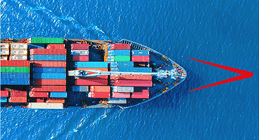While the last two years have created some serious trade challenges for businesses, it has also created opportunities – depending on your industry sector or customer base. Our increased familiarity with video technology, for example, has allowed companies to provide better customer service to faraway territories.
“The quality of what we are able to do to support overseas customers has dramatically changed, accelerated by the necessities of the last year,” says Nick Tiley, the founder and Director of Cambridge Financial Direction, providing FD services to a number of businesses.
Businesses need to ‘follow the money’ to take advantage of trade opportunities, he says. It’s important to identify who your customers are, and where they are based. Depending on the answers, you might want to look further afield, or focus on domestic sales. For example, a high-end luxury goods manufacturer might want to sell more in China, which, with 9% growth of GDP last year, is creating a large number of millionaires. “We think of China as an area for offshore manufacturing to reduce cost, but actually it’s a big consumer market to sell into.”
There are other growing markets in the Middle East, South America and Africa. Europe and the US are not the only options anymore. But moving into a new territory takes a lot of effort. It’s important not to run before you can walk, says Tiley.
“Pick the biggest market and go with it. Once you’ve set up arrangements in one market, it’s actually easier to do it in another. It’s like learning a foreign language. Once you’ve learned one, the second and third will be easier. Some people make use of government trade support missions. Sometimes these have gone well, but it’s often more about finding a distributor or somebody to work with that you trust in that country.”
One route into a new market is to speak with manufacturers that make similar products but aren’t competitors. For example, a company that makes amplifiers might be able to call on a loudspeaker manufacturer to get information and advice about distributors and partners.
Getting into new markets is less structured than it was, thanks to e-commerce. Amazon and other third-party logistics services are available to companies and could open up new routes to market without impacting too heavily on margins. “You could have a route to market that was mainly e-commerce, driving customers to a website to buy the products from, with a third-party logistics hub in the region that is doing order fulfilment.”
Changes in trade relationships have also created domestic opportunities, particularly for more bespoke products. With more trade barriers between the UK and Europe, it is harder for European competitors to do business in the UK, giving domestic manufacturers a chance to grow their market share.
“Maybe you should be chasing business that was going to European competitors,” says Tiley. “But it comes back to what your product is, and who your customers are, to understand where you go.”
This needs to be balanced with supply-chain issues. How acutely these are felt depends on the materials you are purchasing. For example, it’s difficult to get silicon chips at the moment, which has particularly impacted the automotive industry. Ford, for instance, has reduced the number of Ford Fiestas it is manufacturing, resulting in the Fiesta falling from its spot as the best-selling car in the UK.
Getting around these issues isn’t necessarily easy, either. While some will be able to source from markets such as China, for others, such a long supply chain may not be more cost effective when you factor in stock holding and freight costs. It’s worth looking at the options available for sourcing materials, from nearer territories to onshoring, says Tiley.
“I know quite a few subcontract metalwork companies in the UK that have been buying new machines to increase capacity to deal with increased demand. You can be more agile and flexible, and respond to market changes better with a short supply chain. But there’s no doubt it’s still cheaper for bulk goods going from Taiwan or China if that suits your model.”
Manufacturers are currently operating somewhere between ‘just in time’ and ‘just in case’, says Tiley. Some companies are choosing to hold more stock, but the cost of that can have an effect on cash flow, particularly as a lot of commodity prices have gone up.
“It’s been a double hit on stock holding costs (price and quantity). I’ve been in and out of various banks talking about different facilities, but they don’t want to lend money for stock. So you have to find something that they will lend money against.”
Some sectors will find the next 12 months easier than others. Packaging manufacturers are riding the wave of an increase in e-commerce in the wake of the pandemic. Luxury goods companies are also doing well as we’ve seen more people with disposable income that they would usually spend on holidays. Subcontract manufacturers have benefited from more onshoring. Pharmaceutical companies are also performing well. Conversely, Aerospace is currently struggling, as are manufacturers that predominantly supply hospitality businesses.
“It’s good practice to do a bit of strategic planning,” says Tiley. “Ask yourself: what is our market? What is our product? Who is our customer? Where are we going to get to? What are we going to do more of and less of? People are thinking more openly about their relationship with Europe because of Brexit. It’s an opportunity to review your routes to market and find new ways to reach your customers.”
Trade: clean growth and tech
Clean growth and the application of major emerging technologies to existing sectors are two key characteristics of trade in 2022. Add to these levelling up supported by foreign direct investment, and there are exciting future prospects for business and the prosperity of communities globally.



